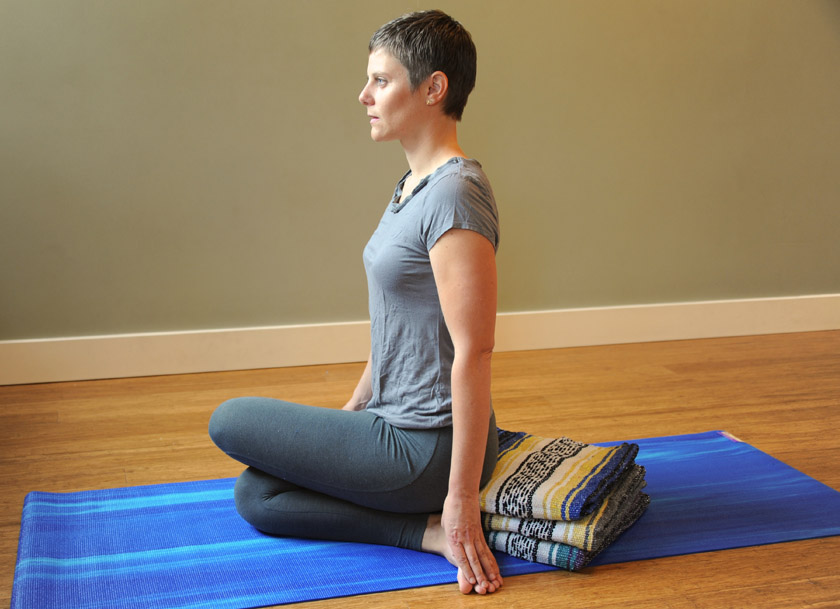
It’s common knowledge that cows hold sacred status in India. To ancient nomadic and farmers, cows represented wealth, nourishment and nurturance. While they are valued for their milk that yields staples of the Indian diet—ghee, yogurt and cheese—cows are not slaughtered for their flesh. Only when a cow dies of old age can her hide be made into shoes.
In Hindu mythology, Nandi the bull is a constant companion to Shiva, the Lord of Yoga. Nandi not only provides Shiva with ground transportation, but he also shuttles Shiva and his wife Parvati around the Universe.
The cow has not always enjoyed exalted status in my yoga classes, however. Gomukhasana (Cow Face Pose) was at one time given nicknames such as “Mad Cow” and “Cow Pie.” Over time, the same folks who were initially cowed by pose have come to revere it. If I do not teach Gomukhasana in my morning classes, most of my students will sacrifice a few minutes of their Savasana (Relaxation Pose) to practice their sacred cow.
Gomukhasana is one of the 15 poses described in the Hatha Yoga Pradipika, the text that outlines the centuries-old physical practices of yoga. Cow Face Pose stretches the deep hip rotators, gluteal muscles and abductors of the legs, making sitting more easeful. One Cow Face convert claims that practicing Gomukhasana transports her—perhaps like Shiva and Parvati—to an alternate universe.
Gomukhasana traditionally incorporates both shoulder and leg positions. For this column, I’m going to focus on the base—the leg position. Practiced without the shoulder stretch and with an added forward bend, Gomukhasana grounds and settles your nervous system, making it a wonderful pose to do toward the end of your practice, to prepare you for Savasana.
How to Practice Gomukhasana
- Begin by sitting on a yoga mat. You might want to have a firm blanket or a couple yoga blocks handy.
- Bend your right knee and then place your right heel next to your left outer thigh with your knee on the floor, pointing straight ahead. Bend your left knee and place it directly on top of your right knee with your left foot next to your right outer thigh.
- You may find that your left knee is unable to rest atop your right knee. Not a problem. This is a perfectly legitimate Gomukhasana, as long as your ischial tuberosities (sit bones) are evenly grounded. However, if your left ischial is nowhere near the floor you’ll need to modify. If your ischial tuberosities are not contacting the ground evenly, the rest of your torso will have to distort itself in order for you to keep from falling over. Place a folded blanket or yoga block under your sit bones. If your sit bones are still not evenly grounded, straighten your right leg out, letting it rest flat on the floor with your left leg still bent on top of it.
- Another reason you might want to try the above variation of Gomukhasana (bottom leg straight) is if you feel any discomfort in your right knee. Discomfort in your knee is never a good thing. Knee discomfort means that ligaments and tendons are being stretched. This is a recipe for destabilizing your knee joints. No yoga pose is worth destabilizing your joints.
- If both sit bones are resting on the floor evenly and your right knee feels fine, you might enjoy interlacing your fingers in between your toes. My students who are familiar with Chinese meridian theory say that this hand-to-foot relationship stimulates all the meridians simultaneously.
- You can either sit with your torso upright, or you can bend forward from the pelvis, placing your forehead on an upright yoga block if it will reach. If you have two blocks, you can stack them up to meet your forehead. Resting your forehead can help quiet your brain.
- Breathe deeply, expanding your back body on your inhalations. Allow your body to settle on your exhalations.
- After 5 to 10 deep breaths, allow an inhalation to lift your torso back up to vertical. Uncross your legs, stretching them both out in front of you on the floor. Feel the residue of the pose—the sensations in your legs, the natural rhythm and depth of your breath, the character of your mind. Then repeat on the other side.
- It is quite common for the sides of the body to be very different. Even if you bent both knees on the first side, you may need to practice the straight-leg variation on the second side or vice versa. Remember that the awareness that allows you to adjust for your own body’s variations is a far greater indication of yogic depth than what your pose looks like.
For years I wondered why Gomukhasana was named Cow Face. In Downward Dogs & Warriors, author Zo Newell suggests looking downward at your legs while sitting upright in Gomukhasana. There you might see the suggestion of a cow’s face—your knees as the nose and your feet as the ears. I like this. Not only does Newell’s suggestion provide the most cogent explanation I’ve heard so far, it also reminds me that yoga poses are not about what they look like from the outside. Gomukhasana teaches us to look inward, to experience ourselves from the inside.
